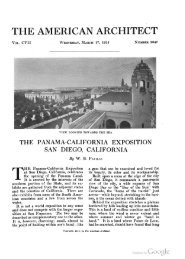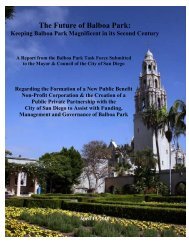Colonel David Charles Collier - Committee of One Hundred
Colonel David Charles Collier - Committee of One Hundred
Colonel David Charles Collier - Committee of One Hundred
Create successful ePaper yourself
Turn your PDF publications into a flip-book with our unique Google optimized e-Paper software.
Information is not available regarding <strong>Collier</strong>'s activities during the next six years.<br />
He visited or lived at times in Philadelphia, Chicago and New York City. In 1929 he was<br />
admitted to the Illinois bar. 75 He may have acted as an intermediary in the sale <strong>of</strong> goods<br />
from Brazil. In 1930 he contributed toward developing the theme <strong>of</strong> the 1933 Century <strong>of</strong><br />
Progress Exposition in Chicago. 76<br />
In the fall <strong>of</strong> 1930, <strong>Collier</strong> returned to San Diego and resumed the practice <strong>of</strong><br />
law. 77 He lived on Park Boulevard, but visited a retreat near Ramona, possibly his former<br />
home at Ballena, whenever he could. Carl Heilbron, his former partner, owned the retreat.<br />
Much <strong>of</strong> <strong>Collier</strong>'s practice came from clients in the Ramona area. 78<br />
In June 1932, <strong>Collier</strong> came in fifth in an election for the Board <strong>of</strong> Supervisors. As<br />
a person who had spent most <strong>of</strong> his life selling real estate, he, not surprisingly, favored<br />
lowering property taxes. 79<br />
Resilient by nature, a defeat could not keep <strong>Collier</strong> down for long. In 1931 he<br />
declared that San Diego could make its waterfront as attractive as Balboa Park, if it held a<br />
Centennial Exposition there. 80 Most people in San Diego ignored the suggestion.<br />
After Frank Drugan secured promises <strong>of</strong> federal and industrial support and <strong>of</strong><br />
exhibits from Chicago's Century <strong>of</strong> Progress Exposition, power brokers in San Diego<br />
endorsed Drugan's plan. They chose Balboa Park as the site for the California Pacific<br />
International Exposition, to be held in 1935-36. No one thought to ask <strong>Collier</strong> for his<br />
opinions. 81<br />
On November 13, 1934, <strong>Collier</strong> died <strong>of</strong> a heart attack at Scripps Memorial<br />
Hospital in La Jolla. 82 He was 63 years old. Funeral services were held November 15, at<br />
the Bradley-Woolman funeral parlor, under the auspices <strong>of</strong> the San Diego Lodge No. 35,<br />
<strong>of</strong> the Order <strong>of</strong> Masons. He was buried in the Masonic plot at Mount Hope cemetery in<br />
San Diego. 83<br />
In 1936 Mrs. <strong>Collier</strong> moved back East to live with her daughter. After she died,<br />
April 28, 1968, her body was taken to San Diego for interment alongside her husband's at<br />
Mount Hope Cemetery. 84<br />
<strong>Collier</strong>'s death prevented him from getting permission <strong>of</strong> the U.S. Congress to<br />
pursue a suit to win title from the U.S. Government for land at Fort Rosecrans. He<br />
claimed the government did not have clear title. If his suit had been successful, <strong>Collier</strong><br />
would have received 75 percent <strong>of</strong> the pr<strong>of</strong>its from the sale <strong>of</strong> 85 estates. Judge George<br />
Thompson, in the Superior Court, July 27, 1937, canceled <strong>Collier</strong>'s filing fee and<br />
discharged him as administrator <strong>of</strong> the estates as he was no longer living. 85 The suit was<br />
another <strong>of</strong> <strong>Collier</strong>'s bold schemes. If he had won, he would again have become rich. As it<br />
turned out, he was close to bankruptcy when he died. His widow was left with $2,000 in<br />
uncollected fees for legal services and a debt <strong>of</strong> over $42,000 in claims against her<br />
husband's estate. 86







